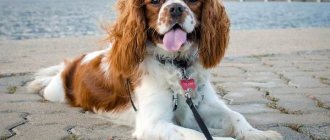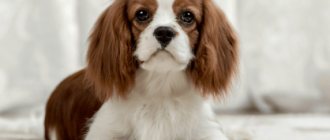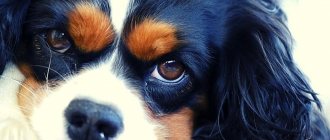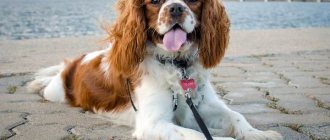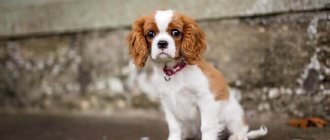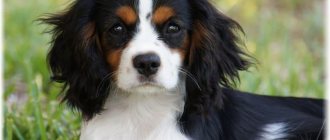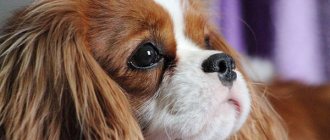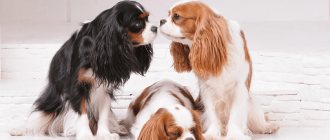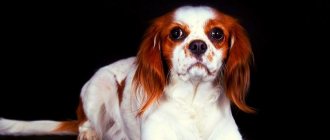| Origin: | Great Britain |
| Usage: | companion |
| Color: | tricolor, ruby, blenheim, black and tan |
| Dimensions: | height 30.5 – 33 cm, weight – 6 – 8.2 kg |
| Lifespan: | 12 – 15 years |
The Cavalier King Charles Spaniel is a toy dog originally from England. This gentle and cheerful pet is called the best companion. It suits everyone - from families with children to single elderly people. The popularity of the breed has not subsided for several centuries due to its flexibility, optimism, sensitivity and beautiful appearance.
Appearance and standard
The description of the breed speaks of the Cavalier as a proportional, strong dog with a large head relative to the body. Males and females are different: the former are stronger and more muscular.
The size is small - height at the withers ranges from 30.5 to 33 cm. The breed standard does not strictly limit weight - the main thing is that the adult dog has a proportional build without signs of exhaustion or obesity. Average weight – 6 – 8 kg.
Frame
The body format is square, sinewy, and the bones are well developed. The back is straight with a convex loin and sloping croup, the shoulder blades are pressed to the back. The chest is deep, the stomach is slightly tucked.
The tail is decorated with wool, with dewlaps. Previously it was cropped, but now it is not cropped. The animal holds it low.
Head
The skull is flat between the ears, with a convex forehead. The muzzle tapers to the lobe, the nose is black. Lips with black mucous. Scissor bite.
The ears stand high, hang down to the sides of the head, and are covered with thick, long hair. The eyes are set low and wide, large, dark in color, bordered by black eyelids.
Limbs
Paws are straight, moderately long. Placed vertically under the body. The front ones are pressed to the chest, the rear ones are slightly pulled behind the hip line.
Paw pads in a ball. Hair grows between and around the toes, forming “slippers.”
Coat
The coat is long, thick, slightly curled. There are featherings on the ears, back of the hips and tail. The characteristics of the breed exclude dogs without dewlaps.
Color
The cavalier's colors deserve special attention. They developed historically. There are 4 types of suit:
Black and tan or King Charles color. The main color is black with bright tan spots above the eyes, inside the ears, on the cheeks, chest, paws and under the tail.
Ruby colored Cavalier King Charles Spaniel. Bright red or red with a mahogany tint. Stains are not allowed.
Tricolor. It is also called black and white and tan or Prince Charles coloring. The background color is white with symmetrical black spots and tan. There are dark glasses around the eyes and black ears.
White-chestnut or Blenheim. The background color is white with symmetrical chestnut spots. Special requirements for the head: the ears and skull must be chestnut, the muzzle must be white, and there must be a white diamond-shaped mark in the middle of the forehead.
There is a legend associated with the Blenheim color. In 1704, the Duke of Marlborough fought in Bavaria near Blenheim. His wife, worried about her husband, calmed herself down by stroking the dog on the head. Soon after the owner returned, the bitch gave birth, and on the top of the head all the puppies had a red spot, like a fingerprint. It was called the “Blenheim spot” and has since been considered an outstanding breed characteristic.
You can find out what a dog of a certain color looks like by looking at the photo.
Appearance Standards
The height of these graceful and graceful dogs is 30-33 cm, their weight is only 5-8 kg. They have large eyes, the shape of the muzzle is elongated, the back is straight and the body is not stretched, and there are decorative strands on the ears.
The tail continues the line of the back; some owners dock it, but this is not a prerequisite. The coat of this breed is silky, it can be slightly wavy, but not curly.
According to existing standards, color can be of four types: Blenheim dog (the entire surface is white and there are red-chestnut spots on it), tricolor (black markings on a white background), tan (the surface is black and there are red-brown markings on it), ruby color .
Character traits
Dogs are tireless optimists. They have an inexhaustible supply of mischief and energy. Dogs are very active and playful up to 2 years old. Adult animals are calmer, but do not lose their enthusiasm until old age.
Attention is vital for gentlemen. Sometimes more than food. They need to constantly communicate with people. If you don’t devote time to your pets, they become picky, capricious, become withdrawn, nervous and fearful. It is advisable to have someone from the family at home at all times.
When a small spaniel lacks attention, he attracts it in his own way. For example, he hides slippers or a remote control. And then, together with the owner, he “searches” for the thing. It's so much fun!
The breed is not vicious and adapts to the lifestyle of its owner. All people are her friends. The pet happily greets family members and strangers. Maybe they'll play with her. And if you’re lucky, they’ll also treat you.
Sometimes pets are stubborn, some of them are possessive. They do not like to share toys and can “take” household items for themselves - plastic dishes, buckets, basins. It is not possible to return items. It's easier to buy new ones.
The dogs bark moderately. They make a voice when guests visit, during games, or if they attract people's attention.
The Cavalier is prone to biting. Usually this is a mistake in upbringing, but the breed has such characteristics. Therefore, grabbing hands and feet with teeth and light biting during play are suppressed.
Rules of maintenance and care
When keeping dogs of this breed, usually no problems arise, but they should not be kept on the street, but in a house or apartment. They do not require much physical activity; short daily walks are enough for them. Cavaliers are not picky when it comes to food, but you need to carefully monitor the condition of their ears, as they are poorly ventilated, which is why otitis media often develops.
It is recommended to spend a few minutes daily grooming their coat using a bristle brush and a metal comb. You don’t need to bathe your dog often, but after each walk you need to pay attention to your pet’s ears and paws, as this is where a lot of dirt accumulates.
Application
The main purpose of a gentleman for several centuries has been to be a companion. He will not make a watchman or security guard - the pet loves people too much.
Moreover, this is not a dog of one owner. He is equally gentle and courteous with all family members, their relatives, friends and passers-by. Some owners scold their “traitors,” but that’s their character.
The dog can be used for short hunting or its imitation. He willingly picks up a bird, chases wild rodents, and “fishes.”
Character and intelligence
Dogs of the King Charles Spaniel species inherited their character from their aristocratic ancestors. This pet is an absolute representative of the companion category; such dogs are ideal for living with a family. They become very attached to their owners and protect and love them. They don’t engage in fights with their relatives, they are not interested in this, but playing with the owner is for them.
The King Charles Spaniel dog breed loves to interact with children and is also calm with other pets other than dogs. Joyful and playful are the exact characteristics of this breed. Thanks to its innate hunting skills, this breed has a well-developed intelligence.
At the time of their appearance at court, they were trained and tried to teach them to hunt. These dogs performed well among other breeds, so they quickly gained the trust of hunters. They are easy to train; their owner may not be a leader; a gentle and calm person is enough for them.
Attitude towards children and others
Since the King Charles Spaniel breed is sociable, it can be trusted to raise and protect children. You can be sure of these dogs that children will not be left without attention or protection. King spaniels are funny dogs and love to play with children who also love to play. The child is a great friend for them, and they will always be happy to have him.
Kings, at the sight of familiar owners, begin to joyfully wag their tails, fawn and win strokes. The animals are very friendly and loving. When in the fresh air, they behave calmly and avoid conflicts with other dogs. Kings are more comfortable with their owner than with their relatives. This is one of the few breeds that is always near the owner, thanks to its affection and love for him.
Upbringing
Gentlemen have average intelligence. They are smart enough to master the OKD (general training course). But you'll have to work. Pets only respond to treats and rewards. If you scold them often, they become isolated and refuse to obey.
Otherwise, training the Cavalier King Charles is easy. Dogs have no desire to dominate. They don't need to prove their authority - they listen to anyone who is bigger than them. Therefore, even children can raise a pet.
If desired, pets are taught sports cultures: agility, freestyle, pitch-and-go. But it will take a lot of patience and time.
Education and training
These dogs have very developed intelligence, so they quickly understand and learn commands. However, after a certain time, the spaniel may stop following the owner's commands due to boring activities.
Dog handlers advise training to be carried out in the form of active play, constantly introducing variety and acting exclusively with affection.
Since the dog has quite developed hunting instincts, during a walk a representative of the royal breed can find an object to pursue. Therefore, you need to teach the dog basic commands - “come”, “fu”.
It is necessary to raise an animal from the first days of its appearance in the house, because often such pets take part in exhibitions. From the age of five months, it is necessary to accustom the puppy to the show stand. Initially, the position is reinforced with encouragement, and as soon as the baby understands the essence, he is taught the command “stand!”
Experienced handlers advise dividing the training of the command “stand!” and “sit!” by time. First, the dog must master the command that fixes him in the stance, otherwise at a crucial moment he may confuse the commands.
Socialization
Cavaliers get along with everyone. They are sociable and do not like to conflict: suddenly they want to “talk” to the cat with whom they had a fight 5 minutes ago. Therefore, pets avoid quarrels.
Dogs are not aggressive towards other animals. They enjoy playing with cats, rabbits and parrots. Although sometimes they can remember hunting instincts and chase the little animal. But this is rare. All that a Cavalier Charles Spaniel harms another animal is excessive intrusiveness.
Pets love children. They are ready to endlessly run around the yard with the little ones. Moreover, they involve both “their own” and the neighbors’ little ones in the games. However, you should not leave your pet alone with the baby: the latter can injure the fragile dog.
Dogs are socialized from the first weeks of life. They are introduced to as many people, children, and animals as possible. They take you around the city and teach you how to behave correctly in public places.
With a lack of socialization and attention, the Cavalier King Charles Spaniel dog will become stubborn, capricious, and cowardly. She will refuse to walk, be afraid of other people, noisy places, animals
History of the origin of the breed
All varieties of spaniels have been popular since ancient times as hunting dogs. Dwarf or toy spaniels became famous around the 9th-11th centuries. They were kept in castles and palaces of dukes and even kings. At first they were used for hunting, but gradually they turned into decorative pets. Images of these dogs can be found in the paintings of many famous artists.
Since the time of Charles II, the words king (king) and Charles (the name Karl is written in English as Charles) have appeared in the name of the breed. These dogs enjoyed privileges like royalty and were even allowed into parliament. Noble ladies carried these small fluffy dogs in their arms. They kept them warm and served to attract insects, which were common in voluminous hairstyles at that time.
During the reign of William III, the popularity of spaniels began to decline. This king liked pugs and other short-faced dogs. To please him, breeders began crossing King Charles Spaniels with Japanese Chins and Pugs. As a result of this selection, the appearance of the breed's representatives has changed greatly.
At the beginning of the 20th century, enthusiasts began to revive the King Charles Spaniel. They bred dogs with traditional appearance. To avoid confusion, the revived breed was called the Cavalier King Charles Spaniel. The word “Cavalier” was added because this was the name given to supporters of King Charles, during whose reign the breed was especially popular.
The Fédération Cynologique Internationale officially recognized this breed in 1955. These dogs began to spread throughout the world. In Russia they have been known since the beginning of the 20th century, but they became popular only in the 80s.
Health
The Cavalier King Charles Spaniel is a long-living breed. The average life expectancy is 12–16 years, unless one of the hereditary diseases manifests itself:
- pathologies of the heart and blood vessels;
- Legg-Perthes disease;
- spinal hernia;
- epilepsy;
- hydrocephalus;
- eye problems;
- Flyketching is uncontrolled, continuous clicking of teeth.
King Charles are prone to ear and eye infections. Make sure that dogs do not jump off surfaces - dislocations and fractures are common.
Cardiovascular diseases are the scourge of the breed. From the age of 2, the dog is checked for these pathologies every six months.
How long doggies live largely depends on their care. They are shown to the veterinarian every 6 to 12 months: if the disease is detected at an early stage, it can be easily cured.
Vaccinations
This dog breed is susceptible to infectious diseases. Therefore, the puppy is vaccinated from 2 months on:
- leptospirosis;
- parainfluenza;
- enteritis;
- plague;
- hepatitis A;
- adenovirus.
At 6–7 months, the King Charles is vaccinated against rabies.
Features of keeping a Cavalier King Charles Spaniel
This breed is intended for indoor keeping. She gets along well even in a small apartment. You just need to immediately provide the puppy with suitable conditions. In addition to comfortable soft bedding, bowls for water and food, and toys, such a dog will need a carrier and a home enclosure.
The carrier is needed for visits to the veterinarian, and it is recommended to close the pet in the enclosure when he is left at home alone. Then he will not have the opportunity to chew things or wires. But the enclosure should not be used for punishment or when the pet becomes too annoying.
Another feature of keeping representatives of this breed is that puppies have weak joints. You need to pay attention to the flooring. If it is slippery and your pet's paws move apart, he may develop an abnormal gait and his limbs may become twisted.
These dogs can be toilet trained at home using a diaper, but they must go outside. They do not require much physical activity, but walks should be active. An adult pet needs to be walked 2-3 times a day for about 30-40 minutes. It is recommended to take more walks in parks and squares, where the dog can run on soft ground and grass. When walking monotonously on asphalt, dogs quickly become overtired.
Caring for a Cavalier King Charles Spaniel is easy. They require the usual hygiene procedures for all dogs.
- Particular attention should be paid to your pet's ears. They are hanging, poorly ventilated, and inflammation often develops in them. Therefore, the ears need to be inspected and cleaned several times a week.
- You need to check your eyes every day. Remove dirt that accumulates in the corners with a cotton pad. You can soak it in chamomile infusion or veterinary lotion. If the eyes run and the fur underneath turns brown, it needs to be treated with a special product.
- It is recommended to brush your teeth with a special toothpaste 2 times a week.
- Cavaliers' claws are sharp and hard. They don't grind well on their own. Therefore, you need to trim them a couple of times a month.
- Be sure to wash your paws after every walk. To make it easier to keep clean, you can trim the fur between the toes. In winter, the pads require care - they are lubricated with cream or oil. The reagents that are sprinkled on roads often corrode the skin, causing cracks and wounds.
- Treat fur regularly for ticks and fleas. It is better to use medications recommended by a veterinarian; these dogs are prone to allergies.
Grooming
The main advantage of the breed is its beautiful silky coat. It is not customary to cut it, although some owners give their pets a hygienic haircut. The peculiarity of the coat of these spaniels is that it does not smell, does not cause allergies and almost does not tangle. Therefore, grooming is simple and can be done independently.
You don’t need to comb the coat often – once every 3-5 days is enough. Only during molting should this be done daily. Although little by little, the hair of these dogs is constantly falling out. For this procedure, it is recommended to use combs with rare and frequent teeth and brushes. It is useful to go over your pet's fur with a silicone mitt. Special sprays will make combing easier and improve the condition of the coat.
It is recommended to bathe your pet once a month. Along with a special shampoo, you need to use a conditioner to make it easier to comb the coat. Show animals are bathed every week. They use balms, oils and other products that smooth the coat and give it shine. After bathing, it is better to dry your dog with a hairdryer. Then she won’t catch a cold, and the wool won’t rot and deteriorate.
Nutrition
These dogs can be fed both natural food and dry food. When choosing the second option, you need to take into account that representatives of the breed are prone to allergies. Therefore, the food should not contain chicken, soy, wheat and other allergens. You need to carefully study the composition; it should not contain artificial additives, dyes, or flavors. For these spaniels, super-premium or holistic food is more suitable.
Most veterinarians recommend feeding these pets a natural diet. You just need to make the right diet and not overfeed the dog. Cavaliers are prone to obesity; with a large amount of carbohydrates in their food, they quickly gain weight. Adult dogs are fed 1-2 times a day.
The menu for dogs of this breed should include:
- lean meats - beef, rabbit, turkey - at least 40%;
- several times a week offal and sea fish;
- cereals – buckwheat, rice, oatmeal;
- dairy products;
- vegetables - zucchini, pumpkin, cucumbers, tomatoes are especially useful;
- seasonal fruits;
- 1-2 times a week – egg yolk.
On the recommendation of a veterinarian, vitamin and mineral complexes should be added to food for healthy joints and improved coat condition. Greens, bone meal, fish oil, vegetable oil, flax seeds are useful. Sweets, sausages, smoked meats, spicy and fatty foods, and legumes are prohibited for your pet. You should not give potatoes, bones, mushrooms, pork, baked goods, or river fish.
Health
The average life expectancy of representatives of this breed is 9-12 years. But with proper care and nutrition, they can live up to 15 and even 18 years. Although the health of the cavaliers is poor, which is associated with inbreeding during breeding. The joints and spine are especially affected. With age, patellar instability, arthritis, and dysplasia may develop. Dogs are also susceptible to joint dislocations and other injuries, and are prone to gaining excess weight.
The most common disease, which affects half of the adult representatives of the breed, is valve prolapse or myxomatous degeneration. It develops especially often after 10 years of age - it is the main cause of death in pets. There are several other congenital and acquired diseases that are characteristic of this breed:
- dry eye syndrome, cataracts;
- ear inflammation and hearing loss;
- allergy;
- syringomyelia;
- inflammation of the paraanal glands;
- diabetes;
- epilepsy;
- false pregnancy in bitches.
How much do puppies cost?
The price for affectionate companions is steep. The cost of pet-class puppies is from 35,000 rubles, breeding – from 60,000 rubles. It is impossible to say how much a show class costs: they are sold for 80, 100 and more thousand rubles.
You can buy a puppy from breeding parents in the following nurseries:
- https://royal-suite.ru – Moscow;
- https://www.evidence-love.com – St. Petersburg.
Pets are popular in Europe and America. In Russia, the breed is only gaining momentum. It has its pros and cons. But dogs are predicted to have a great future in the CIS countries because of their flexibility, cheerfulness, beauty and easy care.
Price and where to buy a puppy
Since the end of the last century, interest in representatives of the breed has increased in Russia. Naturally, purchasing a purebred puppy is only possible in a well-known nursery that values its reputation. In addition, breeders always stay in touch with the new owner of the puppy and will always come to the rescue and advise on issues of maintenance, illness and training.
If you try to save money and look for a representative of the gentlemen in the newspaper or on the Internet, you can buy a mixed breed or even just a similar representative of the mongrel. No one guarantees the health of the pet in this case.
The cost of puppies is quite high and varies from 70 to 100 thousand rubles. Such an expensive price is due to the fact that for this money you will receive a breed or show-class puppy with all the accompanying documents. For this price, your pet will have titled parents and the prospect of a successful exhibition career. In addition, the breeder will do tests for the presence of major pathologies.
Photo: wikimedia.org


